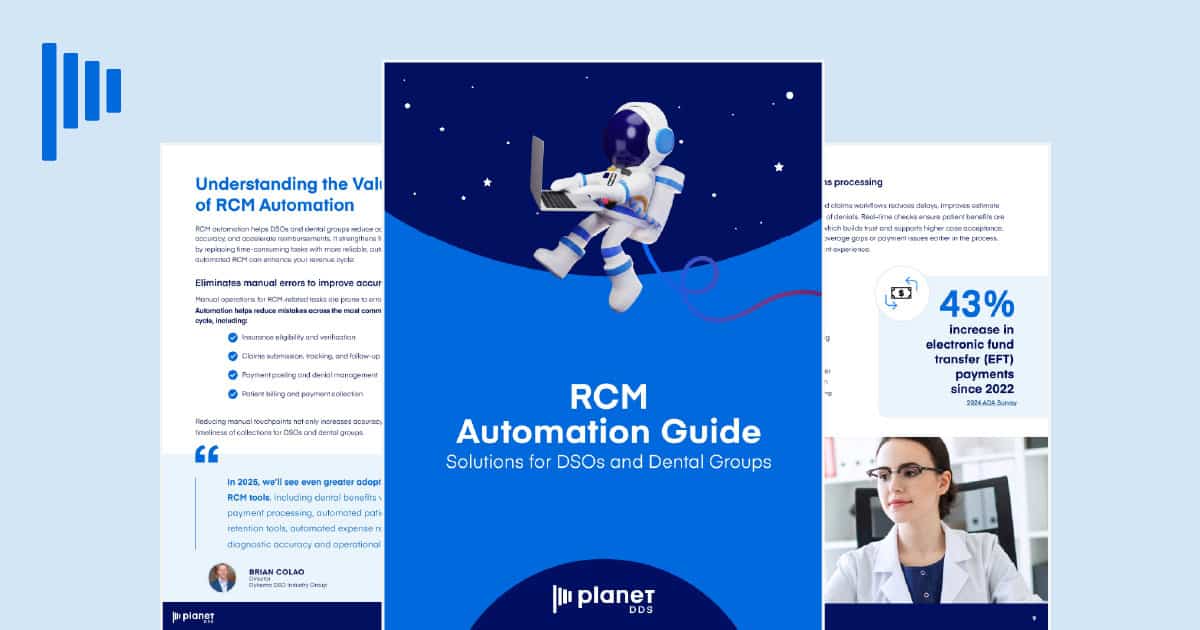RCM Automation Guide: Solutions for DSOs and Dental Groups

Revenue cycle management (RCM) challenges are becoming harder to ignore, especially as staffing shortages, rising costs, and growing administrative demands continue to impact performance. Many dental service organizations (DSOs) and dental groups are rethinking how they manage billing, claims, and collections, recognizing that manual processes are no longer sustainable.
This guide explores how RCM automation can help modern dental organizations operate more efficiently and improve financial performance across every location.
Understanding the Value of RCM Automation
Manual RCM processes often lead to delays, inconsistent collections, and increased administrative work. Automation helps unify the most critical functions—from insurance verification to patient billing—while improving accuracy and cash flow.
Learn how reducing manual tasks allows teams to shift their focus to higher-value activities that support patient experience and long-term growth. As hiring and retention remain key concerns, automation also enables DSOs and dental groups to scale without adding overhead.
Expanding the Role of RCM in Operations
RCM automation now plays a broader role in strengthening day-to-day workflows and financial outcomes. By automating high-volume processes like claims submission, eligibility checks, and patient payments, dental organizations can create consistency across their operations.
Discover how automation reduces the burden on internal teams, accelerates collections, and enhances the patient financial journey, all while strengthening your organization for growth.
Integrating RCM Automation into Your Tech Stack
For DSOs and dental groups managing multiple practices, disconnected systems create inefficiencies that compound over time. Centralizing revenue cycle operations in the cloud helps unify workflows, improve oversight, and reduce friction between teams.
With the right infrastructure in place, DSOs can integrate RCM tools more effectively and build smarter connections between clinical, billing, and scheduling systems. Explore how open APIs and cloud-based platforms allow information to flow between systems, enabling real-time insights and reducing duplication of work.
Measuring the Financial Impact of RCM Automation
To get the most out of automation, organizations need visibility into performance metrics. Tracking A/R days, denial rates, and collection efficiency allows DSOs and dental groups to identify areas of improvement and plan more strategically.
Learn how real-time dashboards and consistent financial reporting can help you evaluate success, improve forecasting, and support better decision-making across your network.
Overcoming Barriers to RCM Automation
Concerns around disruption, system changes, or team readiness can delay automation efforts. However, with the right implementation strategy, those barriers can be addressed early.
Discover how change management, job-specific training, and continued support can help teams adopt tools effectively. Choosing a dental practice management platform that fits within your existing workflows also helps ease the transition and ensures long-term success across your organization
Choosing the Right Partner for RCM Systems
The success of RCM automation often hinges on the strength of your technology partner. For DSOs, that means choosing a company with deep dental expertise, reliable implementation support, and flexible solutions designed to adapt as the organization expands.
Learn what to look for in an automation partner, including ease of use, integration capabilities, and a strong track record supporting multi-location growth.
Accelerate Growth with RCM Automation
RCM automation helps DSOs and dental groups take control of revenue operations across their organization. By improving oversight and reducing inefficiencies, these tools support sustained growth and better alignment between financial and operational goals.
Contact Planet DDS to see how our RCM automation solutions can accelerate growth and improve performance across your organization.



